Easy and Fast Way to Freeze French Fries
Whether you grow your own potatoes, purchase in bulk from the farmers' market, or snag a great deal at the supermarket, a day of prep can fill your freezer full of homemade frozen fries ready to cook quickly for meals.
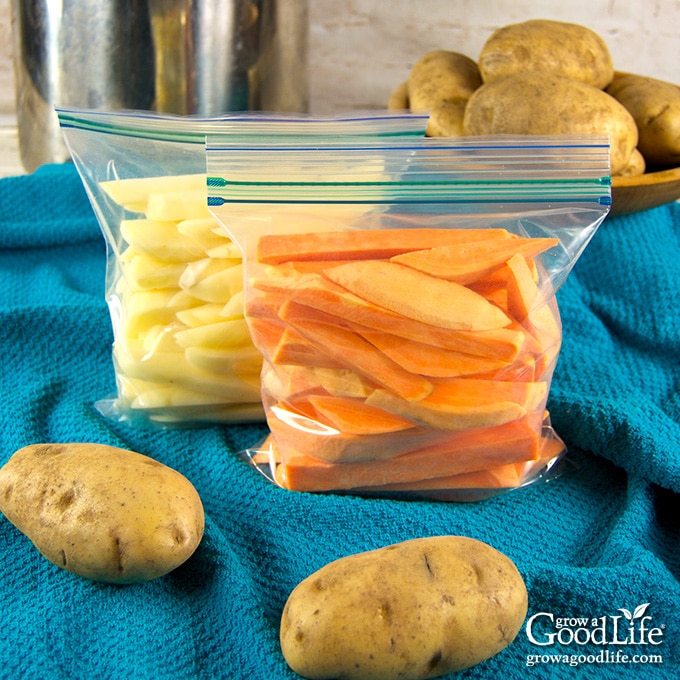
A good way to save time in the kitchen is to prepare food in advance. Making your own homemade French fries and freezing them for later meals is one of those great shortcuts.
Tips for Making Frozen Fries
Cutting potatoes into even strips, and then frying in a deep fryer is the traditional way to prepare fries. However, baked fries and air-fryer fries much easier and healthier to make at home.
Can you freeze potatoes?
Yes, with a little prep, you can preserve potatoes by freezing them. While this article shows you how to make frozen fries, check out this post if you want to freeze potatoes and sweet potatoes in other ways, including diced, mashed potatoes, and hash browns:
- How to Freeze Potatoes
Why freeze your own fries?
While there are plenty of options for purchasing fries at your local grocery store, freezing your own is less expensive, and helps you avoid excess salt, and other unwanted ingredients.
Preparing and freezing fries also cuts down the cooking time allowing you to bake or air fry fries in half the time as making homemade fries from scratch.
Plus you can cut the fries in your favorite shapes, including shoestring, wedges, crinkle cut, or rounds.
Best potatoes for homemade french fries
The best potatoes for making fries are Russet potatoes. Russet potatoes have a mealy texture, low moisture and sugar, and high starch. These features make them perfect for baked or fried French fries that are fluffy on the inside with a crispy exterior. Because of the low moisture, russet potatoes also freeze well. Common varieties include Burbank, Centennial, Goldrush, Norkotah, and Ranger.
Other starchy potatoes that work well for frozen fries include Green Mountain, Katahdin, and Kennebec, Snowden, and Yukon Gold. These contain enough starch to hold up well when blanched and frozen without turning mushy.
If you are using home grown potatoes, select mature, high-starch potatoes that have been cured and stored for about a month. Potatoes that have been cured are lower in moisture and higher in starch. The longer potatoes are in storage, the more the starches convert to sugar. Too much sugar will result in soggy dark-colored fries. These are still tasty and safe to eat, just not as crispy.
Thin skinned, freshly harvested potatoes, along with waxy and boiling types such as, red, white or gold round, fingerling, and colored tubers freeze well, but they may not be as crisp as starchy potatoes because they contain higher moisture and sugar.
Freezing sweet potato fries
Sweet potato fries are a delicious alternative to regular potato fries. The great thing is you can freeze sweet potato fries the same way! If you grow your own, use sweet potatoes that have been cured for at least one week before processing.
How to cut potatoes into fries
To steady the potato and make cutting easier, first slice the potatoes in half lengthwise. Flip the cut portion side down on the cutting board to stabilize, slice the potato lengthwise into slabs the width you want your fries, and then cut these slices into sticks the same width.
The shapes of your fries are up to you. Just keep in mind that larger sizes take longer to cook. Decide how slender you would like your potatoes, and cut them the same thickness, so they cook evenly.
- Shoestrings are long, straight cut, thinly sliced fries also known as matchsticks or julienne fries. Cut shoestring fries about a 1/8 to 1/4-inch wide and watch the blanching time because these cook up quickly. Because they are so skinny, shoestring fries cook up very crispy when baked or air fried.
- Potato Wedges also called steak fries, jojos, or home-style potatoes. They are cut in 1/2 to 1-inch thick potato wedges. Since wedges are much thicker than shoestrings, they cook up with a nice fluffy interior and crisp exterior. To cut wedge shaped fries, first cut the potato in half, and then cut each half into long, thick wedges by angling the knife.
- Cottage Fries, also called rounds, home fries, and dinner fries are coin shaped fries that resemble thick chips. Sometimes they are ridged. To make cottage fries, choose smaller potatoes that under 2-inches wide. Slice the potatoes into 1/4-inch rounds.
- Crinkle Cut Fries are thick wavy fries with corrugated grooved edges made with a special crinkle cutter. I like using this ribbed slicer. Bonus is, crinkle cut fries cook up evenly in an air-fryer because the crinkle cut sides prevent the potatoes from sticking together, and lets the air circulate more evenly.
- Waffle Fries, also known as windowpane, grid, or criss-cross fries are also made using a crinkle cutter. The lattice pattern is achieved by giving the potato a quarter turn after each thin slice. It does take some practice to get the right thickness.
Steps to Freezing Potatoes for French Fries
French fries that are made at home from fresh potatoes taste better than the ones you get at a fast food restaurant. Scroll down for the full recipe at the bottom of the article, but below are the illustrated steps to blanching and freezing potatoes.
Kitchen equipment needed to prepare your fries for the freezer include a large pot, two large bowls, knife, cutting board, vegetable peeler, slotted spoon, sheet trays, parchment paper, kitchen towels, and quart sized freezer zipper bags.
Step 1: Prepare the Potatoes
Scrub your potatoes under running water and pat dry with a kitchen towel. The peeling can harbor botulism bacteria, so to be on the safe side, it is best to peel potatoes that you will be preserving.
As you peel, trim off eyes, scabs, bruises, and green spots. Then rinse the potatoes well under cool water and pat dry with a clean kitchen towel.
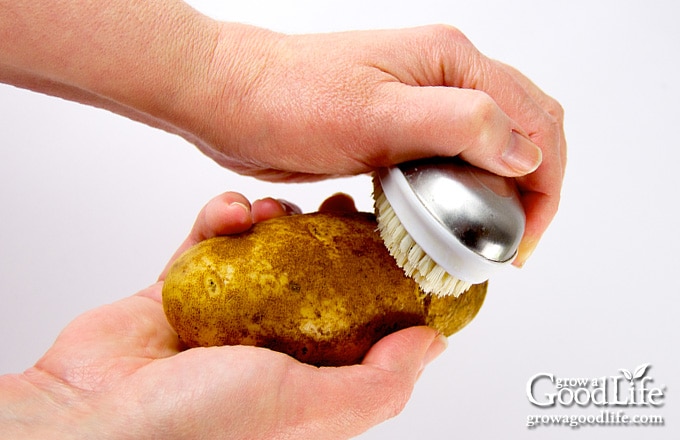
Step 2: Cut the Potatoes into Fry Shapes
Use a knife to cut the potatoes into even thickness fry shapes. As you work, place the cut potatoes in a large bowl of cold water to prevent them from turning grey and to rinse off the excess starch and surface sugars.
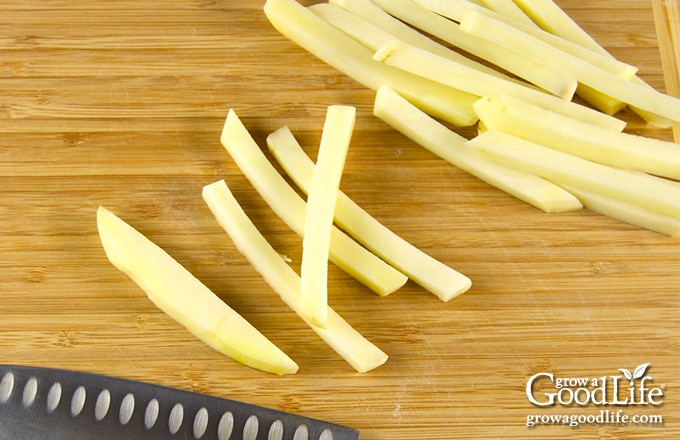
Step 3: Pre-Cook the Fries
Pre-cook your fries by blanching in boiling water and then dropping into a bowl of ice water to stop the cooking process. Blanching partially cooks the potatoes to slow the enzymes that cause lost flavor, color and texture.
To blanch your potatoes, bring a large pot of water to a boil over high heat. While the pot is heating up, fill a large bowl with cold water and ice.
Working in batches, drop your cut potatoes into the boiling water and boil for 2 to 5 minutes. The timing will depend on the size of your pieces. Sweet potatoes take a little longer than regular potatoes.
Potatoes need to be cooked until tender so they won't turn black when frozen. Test a few pieces by poking with a knife in the center of the potato. The interior should be softer than a raw potato, and the knife should easily sink all the way through with no resistance.
Remove the fries and plunge into your bowl of ice water to cool. Once the potatoes are cool, remove them from the ice water and dry well with a clean kitchen towel.
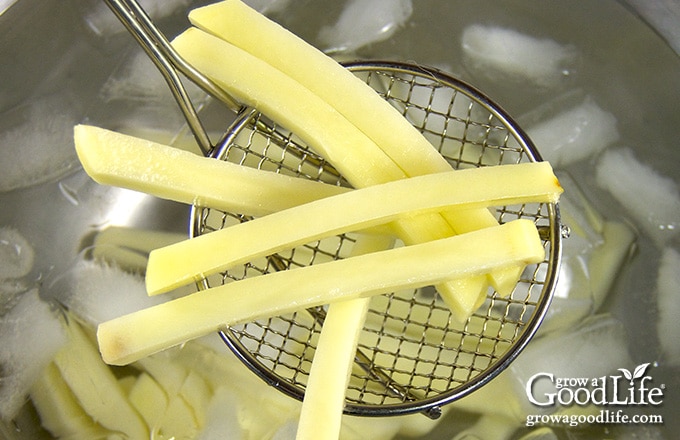
Instead of blanching, you can also precook your fries by baking them in the oven. Preheat your oven to 425˚F and spray baking pans with non-stick cooking spray or line with parchment paper.
After soaking, drain the potatoes, and dry well with a clean kitchen towel. Toss or spray with cooking oil, such as avocado or vegetable oil. Spread the potatoes out in a single layer on the baking sheets, and bake in a preheated oven for 15 minutes, or until slightly brown and softened in the middle. Let the fries cool before freezing.
Step 4: Freeze the French Fries
First, flash freeze the fries on a parchment lined sheet pan so they don't stick together. Spread the potatoes out in a single layer, and place the baking tray in the freezer for about an hour until the potatoes are frozen. If you have a lot of fries to freeze at a time, use a sheet of parchment paper in between layers and keep piling the fries on.
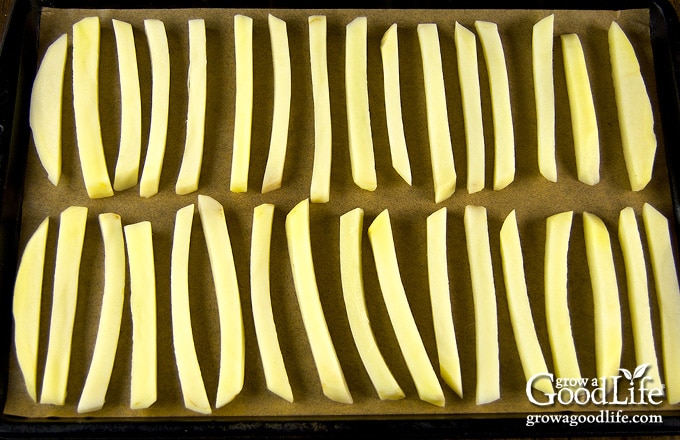
Step 5: Package the French Fries
Pack the frozen potatoes into freezer bags. About two pounds of fries will fit into a quart sized freezer bag. Remove air from the bag, seal, label, date, and store in the freezer for up to 3 months.
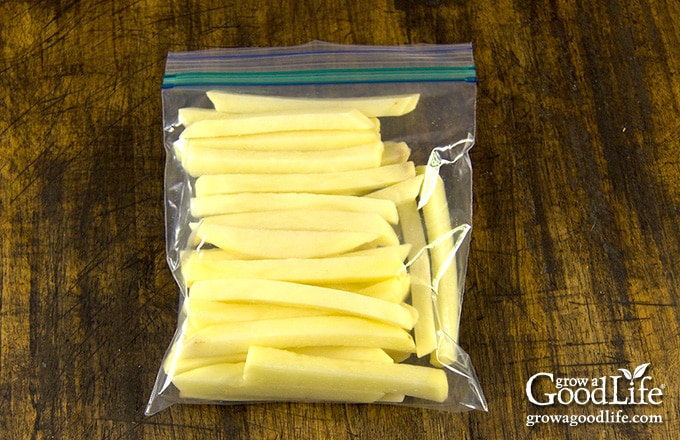
How to Cook Frozen Fries
Keep the fries frozen until you are ready to use them. Do not thaw before cooking or the fries will turn mushy and brown. You can cook your fries in various ways, including baking, air frying, and deep-frying in oil.
Oven Baked French Fries
To bake the frozen fries, preheat your oven to 450˚F. Spray a sheet pan with cooking spray, spread out the frozen fries, spray with more cooking spray, and bake in the preheated oven until brown and crispy, about 12 to 15 minutes depending on the size. Turn about half way through. Season and serve warm.
Air Fryer Frozen French Fries
To cook the frozen fries in an air fryer, first preheat the air fryer to 400˚F. Toss or spray the frozen fries with cooking oil, such as avocado or vegetable oil. Since cooking spray isn't recommended for air fryers, use an oil sprayer instead. Place the potatoes in the air fryer basket, and air fry until crispy, about 15 to 20 minutes. Toss about halfway through so the fries cook evenly. Season and serve warm.
Deep Fried French Fries
To fry, heat a deep fryer filled with vegetable oil to 350˚F, and line baking sheets with paper towels. Add several handfuls of frozen fries to the frying basket, and lower it into the deep fryer. Fry for 4 to 6 minutes, or until the fries turn golden brown. Remove the fry basket and dump on the prepared baking sheets. Season the fries while warm, and repeat with the remaining frozen fries.
How to Freeze Homemade French Fries
Whether you grow your own potatoes, purchase in bulk from the farmer' market, or snag a great deal at the supermarket, a day of prep can fill your freezer full of potato French fries ready to bake or air fry quickly for meals.
Servings 4
Calories 160 kcal
- 2 pounds russet potatoes (or any amount)
- water
- several trays of ice cubes
- avocado oil spray for baking
- salt and seasoning of choice
-
Scrub your potatoes, peel, rinse well, and pat dry with a kitchen towel.
-
Fill a large bowl with cold water.
-
Cut the potatoes into 1/2-inch fry shapes. Place the cut potatoes in the bowl of cold water as you work.
-
Bring a large pot of water to a boil over high heat. While the pot is heating up, fill a large bowl with cold water and ice.
-
Working in batches, blanch your fries by dropping them into the boiling water. Boil each batch for 2 to 5 minutes, or until the interiors are soft.
-
Remove the blanched fries and drop them into the ice water. Let cool for at least 15-minutes.
-
Remove and dry well with a clean kitchen towel.
-
Lay the blanched fries out in a single layer on a parchment lined sheet pan and flash freeze for about 1 hour.
-
Once frozen, place the frozen fries in a zipper bag, and store for up to 3 months in the freezer. Keep the fries frozen until you cook them.
Oven Baked French Fries: To bake the frozen fries, preheat your oven to 450˚F. Spray a sheet pan with cooking spray, spread out the frozen fries, spray with more cooking spray, and bake in the preheated oven until brown and crispy, about 12 to 15 minutes depending on the size. Turn about half way through. Season and serve warm.
Air Fryer Frozen French Fries: To cook frozen fries in an air fryer, first preheat the air fryer to 400˚F. Toss or spray with a cooking oil. Place the potatoes in the air fryer basket, and air fry until crispy, about 15 to 20 minutes. Toss about halfway through so the fries cook evenly. Season and serve warm.
Deep Fried French Fries: To deep fry, heat a deep fryer filled with vegetable oil to 350˚F, and line several baking sheets with paper towels. Add several handfuls of frozen fries to the frying basket, and lower it into the deep fryer. Fry for 4 to 6 minutes, or until the fries turn golden brown. Remove the fry basket and dump on the prepared baking sheets. Season the fries while warm, and repeat with the remaining frozen fries.
Serving: 8 ounces | Calories: 160 kcal | Carbohydrates: 36 g | Protein: 3.8 g | Fat: 0.3 g | Saturated Fat: 0.1 g | Sodium: 52 mg | Potassium: 924 mg | Sugar: 2.6 g | Calcium: 200 mg | Iron: 0.2 mg
You May Also Like:
- How to Grow Potatoes
- How to Store Potatoes for Winter
- Oven Baked Seasoned French Fries
Source: https://growagoodlife.com/freeze-potato-french-fries/
Publicar un comentario for "Easy and Fast Way to Freeze French Fries"